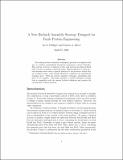| dc.contributor.author | Phillips, Ira | |
| dc.contributor.author | Silver, Pamela | |
| dc.date.accessioned | 2006-04-20T23:42:53Z | |
| dc.date.available | 2006-04-20T23:42:53Z | |
| dc.date.issued | 2006-04-20T23:42:53Z | |
| dc.identifier.uri | http://hdl.handle.net/1721.1/32535 | |
| dc.description.abstract | The existing biobrick assembly technique[1] provides a straightforward
way to combine standardized biological components, termed biobricks.
This system, however, is limited in that each protein-encoding biobrick
must contain a complete translated region. Signal sequences or other protein
domains often convey a specific function to the protein to which they
are attached; hence, each domain should be considered an independent
biological part. With the current assembly technique, assembling such
parts is not possible. This paper presents a revised assembly strategy
that is compatible with the current biobrick definition and permits the
construction of fusion proteins. | en |
| dc.format.extent | 61240 bytes | |
| dc.format.mimetype | application/pdf | |
| dc.language.iso | en_US | en |
| dc.subject | BioBricks | en |
| dc.subject | Standard Assembly | en |
| dc.title | A New Biobrick Assembly Strategy Designed for Facile Protein Engineering | en |
| dc.type | Technical Report | en |
| dc.contributor.department | Massachusetts Institute of Technology. Department of Biological Engineering | |
